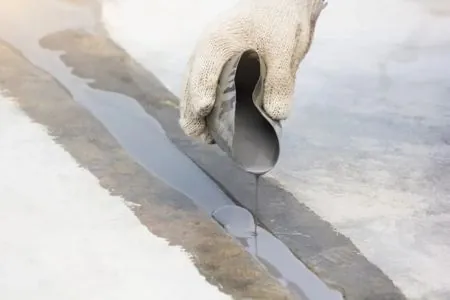When sprucing up your concrete surfaces, comparing the pros and cons of concrete stain vs. paint can be confusing. Both provide protection and a fresh look, but the differences in longevity, appearance, and cost can impact your decision. The concrete stain seeps into the surface, creating a rich, translucent tone that highlights the concrete’s natural texture. On the other hand, concrete paint offers a variety of solid colors, creating a more uniform and finished appearance. Find out which option will best suit your project’s needs and ensure a lasting finish this this handy guide from our concrete finishing pros!
I. What Are the Differences Between Concrete Stain and Paint?

Deciding between concrete stain vs. concrete paint hinges on understanding their core distinctions. Factors such as durability, appearance, and maintenance requirements are crucial in determining the ideal choice for your concrete surface. Let’s take a closer look at these and see which might be best for your concrete finishing needs.
A. Coating or Penetrating
When it comes to giving a patio or any decorative concrete surface a fresh look, the terms “coating” and “penetrating” are key to the discussion. A coat, such as epoxy, provides a protective layer on top of the concrete, delivering both color and a barrier against elements. In contrast, an acid stain penetrates the surface, bonding with the concrete to create a finish that can withstand more wear and tear without peeling off. Things that coat the concrete often change how it looks as far as texture and color. Things that penetrate can alter color a little but keep the natural shades and textured look that the concrete naturally had.
B. Translucent or Opaque
Once you choose between concrete stain vs concrete paint for your driveway or masonry project, it’s essential to reflect on the desired appearance in terms of transparency. Acrylic paint, with its variety of colors, tends to offer an opaque finish, effectively masking the concrete’s natural look. Alternatively, using a dye allows for a translucent effect, enhancing the surface’s porosity and texture without completely obscuring its innate characteristics. The easiest way to remember the difference is this- opaque finishes usually cover any natural shade, tone, or texture elements whereas translucent finishes allow some of these to still show through.
C. Longevity
The longevity of a concrete finish work depends greatly on its ability to withstand environmental factors such as heat, oil, and ultraviolet rays. They can all degrade the surface over time. A concrete sealer, often applied after staining, helps in waterproofing the surface, thus extending its life by providing protection against these elements. Unlike paint, which may crack or flake with prolonged exposure, a properly sealed stained concrete surface is more likely to retain its integrity and appearance for years. The location of your concrete can play into this conservation as indoor foot traffic or outdoor exposure could dictate what kind of longevity protection is best for you.
D. Chip and Wear Resistance
The durability of a concrete surface after using stain or paint significantly depends on the application of a proper sealer. This sealer acts as a moisture barrier, akin to a varnish on wood, and protects the stained or painted layer from mineral deposits and water intrusion. As a result, surfaces treated with a quality sealer are more resistant to chips and general wear, maintaining their appearance over time. Both stains and paints can benefit from a seal coat added when it is all said and done to lock in colors and appearance while adding another layer of protection.
E. Preparation Requirements
Properly preparing your concrete for either stain or paint is critical to ensure the finish will last. Quality concrete coats will hold up under the stress of foot traffic, furniture movement, and general wear. For paint, particularly latex-based paints, cleaning the surface thoroughly and repairing any cracks is essential; this provides a smooth canvas for the paint to adhere to, especially in high-usage areas like a basement or outdoor patio with pavers. With staining, aside from cleaning, the surface often requires a more aggressive profiling to open the pores of the concrete, allowing the stain to penetrate deeply and bond with the material.
F. Application Difficulty
The ease of applying either paint or stain to a concrete slab varies depending on the product and the area to be covered. For example, staining a concrete slab might seem straightforward, but it requires the solution to be evenly applied and absorbed into the cement to ensure a uniform finish. On the other hand, painting might seem less complex since the pigment simply lays on the surface, yet achieving a smooth, even coat demands considerable attention to avoid streaks and brush marks. Whichever method and material you ultimately choose, both should be applied by a skilled and professional concrete expert.
II. Appearance Differences between Concrete Stain and Paint
The aesthetics of stain versus paint vary notably, from the way the finish interacts with light to its visual texture and overall impact. Assessing the final appearance is essential because it influences not only the countertop’s look but also its integration with the surroundings.

A. Finish
The finish you choose for a concrete surface profoundly affects its overall ambiance and aesthetic harmony with its environment. A stained concrete finish tends to breathe life into the surface, showcasing subtle tonal fluctuations and texture that capture and reflect light uniquely. Conversely, paint provides a solid hue, offering a streamlined, uniform look that may stand out or blend in, depending on the chosen color.
B. Color
The color options of concrete stains and paints cater to different visual effects and personal preferences. Stains offer earthy tones and subtle shades that mirror the natural shading of concrete, while paints provide a broader spectrum of colors, from pastels to vibrant hues. Choosing the correct type of finish based on the desired hue and tone impact can dramatically change the atmosphere of a space.
C. Uniformity
Uniformity in the finish of concrete is a notable aspect when comparing stain and paint. Stain may result in a varied look with different shades coming through, providing a natural and organic appeal. Paint, in contrast, often leads to a consistent color across the entire surface, presenting a clean and uniform appearance that is predictable and easy to maintain.
III. Durability Differences between Concrete Stain and Paint
The fight against the elements is a real concern for any surface, and concrete is no exception. When deciding between concrete paint vs stain, it’s important to think about how each holds up under factors like sunlight and heavy use. A stain merges with the concrete, which often means a longer-lasting finish that resists peeling or fading from UV rays.

Paint, however, sits on top of the concrete and can suffer from chipping and cracking as it ages. This means frequent touch-ups might be needed, which can increase maintenance over time. Painted surfaces are also more prone to showing wear in high-traffic areas, reflecting day-to-day life in ways some might find less appealing.
Stain typically requires less upkeep compared to paint. It penetrates the surface, creating a bond with the concrete that’s tough to break. The result? A finish that can often weather the hits from dropped tools, dragged furniture, and the scuffs and marks of everyday living better than its painted counterpart.
IV. Application Differences between Concrete Stain and Paint
Applying concrete stain versus paint involves different processes and challenges. Stain requires thorough surface preparation, including cleaning and etching, to ensure proper color absorption. In contrast, painting also needs a clean surface but often requires a primer for better adhesion and durability.
Stain application can be time-consuming, with the product needing several hours or even days to set. Paint typically dries faster, but may require multiple coats for complete coverage. Staining demands more precision as mistakes potentially resulting in uneven color. Painting offers more flexibility for corrections. It’s easier for those less experienced with concrete finishes.
V. Cost Differences between Concrete Stain and Paint
Paint or concrete stain, the choice often comes down to cost. Stain typically has a higher price per gallon, and you may need a sealer for added durability, making it more expensive initially. Paint usually costs less upfront and is available in a range of price points. However, paint often requires more frequent maintenance and touch-ups, which can lead to higher long-term costs. Consider both the initial expense and future maintenance when deciding. This approach helps ensure that you choose a finish that offers the best value while meeting your needs for durability and appearance.
VI. Conclusion
Selecting the right finish for your concrete surface impacts its durability, look, and upkeep. Stains penetrate the concrete and bond with it, offering a long-lasting finish that requires less maintenance. They highlight the concrete’s natural texture. Paint provides a range of color options and a uniform look but often needs more frequent touch-ups. Although staining may have a higher initial cost, its lower maintenance needs can be more cost-effective over time. But for those looking for a quick fix or a temporary upgrade before selling or doing a renovation, then painting can serve as a good short-term fix.
Choosing the right finish will ensure your concrete surface remains both functional and attractive for years. Contact the local concrete experts today and find out why concrete finishing is best left to the pros!





